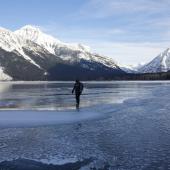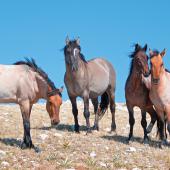Earn Your Turns
A Guide to Alpine Touring
Yurts first sheltered central Asian nomads over 3,000 years ago. They now harbor western Montana nomads - those seeking fresh backcountry stashes, untrammeled slopes, and friendship and fire to burn.
In winter deep blankets of snow transform rugged Montana mountains into slippery, padded bliss. A hush descends on the land. Secretive animals leave telltale tracks in the crystalline snow cover. Snow-loving humans emerge, transformed from plodding bipeds to speedy fun hogs, equipped to leave their own sinuous tracks as they schuss down vast white slopes, grinning and hooting as they carve up the slopes.
Maybe this is the winter you finally try backcountry skiing — also known as Alpine Touring. You can earn your ski turns by paying for lift-access skiing. Or, you can sacrifice some quantity for quality, and earn them through sweat equity — that is, climbing the mountain under your own power. Climbing for your ski turns makes each run more special and memorable. With lots of folks seeking fresh powder and authentic experience, and with YouTube dense with high mountain ski videos, backcountry skiing is booming.
With the right gear and a go-to attitude, you can create your own ski experience nearly anywhere there is good snow and safe terrain. Basic gear involves fat skis, Alpine Touring boots and bindings, climbing skins, adjustable poles and a good backpack.
Telemark skiing, another way to approach the backcountry, means that you never lock your boot heels down. It’s a legit and challenging way to ski downhill, and has its hardcore adherents. After 25 winters of Telemark skiing I switched to AT skiing a few winters ago and have not looked back.
My switch required a new set of gear, and it took some getting used to. But that first run with heels locked down I was hooked. It was a return to my old alpine skiing days, but I could do it anywhere! My skiing felt so much more stable and capable, it was like a new sport.
Major manufacturers like Atomic and Fischer are elbowing into what used to be the domain of Scarpa and Dynafit. The hottest trend in Alpine ski boots is the AT/Alpine boot that can be used both at the ski hill and in the backcountry. There’s a lot to be said for the “one quiver” option – laying down the cash for high-quality gear that can be used anywhere.
Dynafit are the gold standard for Alpine Touring (AT) bindings, but Black Diamond, Atomic, Rossignol and Marker all offer worthy options. While the bindings keep improving, the basic Dynafit design is the same — there are two holes in the toe of your ski boot and two pins on the toe of the binding that lock into the boot holes, creating a nearly frictionless pivot point when climbing. The heels of the binding can be easily unlocked and swing out of the way, or adapted to form heel-lift platforms for climbing steep terrain.
While manufacturers offer a dizzying array of AT skis, generally you want a fat, light weight ski with a good shovel at the tip. A softer ski will be more forgiving in variable backcountry snow conditions. You won’t encounter much hardpack in the backcountry, so forget about stiff skis. And no need for symmetrical, two-tip skis since you are unlikely to be hucking off cliffs and landing backwards, unless you are already a badass skier in which case you don’t need this article.
Uphill travel on backcountry skis is commonly referred to as “skinning.” Climbing skins, necessary for any uphill travel, adhere temporarily to the bottom of your skis. They provide traction via mohair and cover the entire bottom of your skis. These should be custom cut to cover the entire ski base except the edges.
There is a real art to skinning, involving weight distribution on skis, poling, route finding, kick-turning, and pacing oneself. Start with some easier approaches to get the hang of it. Whatever the slope, you are guaranteed to get a workout, and it’s a lot more scenic than the stairmaster at the gym.
Poles need to be adjustable so you can make them longer for the ascent and shorter for the descent.
At more popular backcountry ski destinations you’ll find a well-worn “skin track” where other motivated souls have packed in the uphill track for you. However, be forewarned. These pre-made tracks can be a huge help, but some of them are extremely steep and may be difficult to navigate, or may lead you into unsafe terrain. You can always kick in your own track.
Now for the fun part. You’ve slogged up the skin track, working up a good sweat. Time to de-skin, clip and the let ‘er rip. It’s possible to remove your skins without taking off your skis, but it’s like a game of twister on snow. Remove the climbing skins, fold them together and stow them in your pack. Be sure to secure your skis while you do this, so they don’t take off without you! You’ll want to add a layer or two of clothing and maybe put on your helmet. Then you lock down your heels down for the fun part — downhill. Here you finally reap the rewards of the expensive gear and the long climb. Vast, untracked powder fields await your signature as you float down the mountain with the greatest of ease.
Any time you ski outside of a developed ski area, and the slope is 25 degrees or steeper, you are in avalanche terrain. Take an avalanche awareness class first through the Southwest Montana Avalanche Center or the West Central Montana Avalanche Foundation. Get the right gear and do not skimp — an avalanche beacon, collapsible probe pole, stout shovel, and a good backpack are the basics. Always go with friends and make sure everyone is familiar with backcountry ski safety and avalanche protocol, such as skiing one at a time and keeping each other in sight and shouting distance. Practice using your beacons ahead of time and always discuss your plans as you progress in the backcountry. Learn about digging snow pits and assessing the avalanche danger. Advanced rescue gear like an automatic airbag and an Avalung can also increase your chances of survival should you get caught in an avalanche.
Obviously Alpine Touring requires a certain level of fitness if you are going to have any fun. You don’t have to be an uber-athlete, but you need to be ready for aerobic exercise. Cross country skiing, running, hiking, and working out at the gym will all help you prepare for the uphill grunt. You don’t want to be out of gas at the top of the hill, just as the fun begins. Nor do you want to be that guy who holds everybody up.
You can get a taste of AT style skiing at any ski area that offers “side-country” access, such as Big Sky, Whitefish Mountain, or Bridger Bowl. Side-country means you can ride the lift with a standard ticket, then ski outside of the ski area boundary. Once through the gate you must travel with ski partners and have basic avalanche safety knowledge and equipment. Some locations, like the Ridge at Bridger Bowl, require hiking up the “boot-pack” trail to access the ski runs. Others, such as the Big Couloir or North Summit Snowfield at Big Sky, require you to sign out with the ski patrol.
If you want expert instruction and guidance for your backcountry ski career, it’s available, for a price of course. Drew Pogge at Bell Lake Yurt will set you up with a cozy yurt camp in the Tobacco Root Mountains and guide you through the stunning ski terrain of the ‘Roots. Yellowstone Ski Tours’ Beau Fredlund will guide you on ski adventures nearly anywhere in the vast and spectacular ski terrain of Yellowstone. Ben Zavora’s Beartooth Powder Guides out of Cooke City offers a cabin or a yurt for rent and guided ski tours into the magnificent high country of the Beartooth and Absaroka ranges.
Don’t let the complications of backcountry skiing deter you. It can be as simple as cranking off some mellow turns in a low angle meadow in the Bridger’s. Or it can get as involved as a multi-day ski traverse of the Bitterroot Range. However you approach it, you are seeing and skiing wild and varied terrain, building friendships and memories, and earning your turns.












Leave a Comment Here